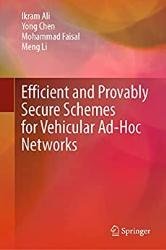Efficient and Provably Secure Schemes for Vehicular Ad-Hoc Networks
- Добавил: literator
- Дата: 13-01-2022, 20:32
- Комментариев: 0
 Название: Efficient and Provably Secure Schemes for Vehicular Ad-Hoc Networks
Название: Efficient and Provably Secure Schemes for Vehicular Ad-Hoc NetworksАвтор: Ikram Ali, Yong Chen, Mohammad Faisal
Издательство: Springer
Год: 2022
Страниц: 237
Язык: английский
Формат: pdf (true), epub
Размер: 21.6 MB
This book focuses on the design of secure and efficient signature and signcryption schemes for vehicular ad-hoc networks (VANETs). We use methods such as public key cryptography (PKI), identity-based cryptography (IDC), and certificateless cryptography (CLC) to design bilinear pairing and elliptic curve cryptography-based signature and signcryption schemes and prove their security in the random oracle model. The signature schemes ensure the authenticity of source and integrity of a safety message. While signcryption schemes ensure authentication and confidentiality of the safety message in a single logical step. To provide readers to study the schemes that securely and efficiently process a message and multiple messages in vehicle to vehicle and vehicle to infrastructure communications is the main benefit of this book. In addition, it can benefit researchers, engineers, and graduate students in the fields of security and privacy of VANETs, Internet of vehicles securty, wireless body area networks security, etc.
The rapid and massive growth in the development of computer systems and wireless network communication technologies increases the range of applications of intelligent transportation systems (ITS) such as vehicular ad hoc networks (VANETs) in smart cities. In recent times, VANETs have received significant attention from academia, industries, and governments due to their importance in traffic management. According to an estimate, the market for vehicular communications in the coming years will reach several billion euros. VANETs can also be considered to be mobile ad hoc networks (MANETs) because they form a dynamic infrastructure in which fast moving vehicles communicate with each other in a secure and efficient way. They can also be considered to be vehicular sensor networks (VSNs) because they allow traffic-related information to be collected by road sensors [9]. In urban areas, the number of vehicles (cars, buses, trucks, etc.) is increasing on a daily bases. This results in an increase in traffic jams and accidents. The main objective of deploying VANETs is to reduce accidents on roads, save the passengers time, and provide a relaxed and smooth driving experience in urban areas. This is achieved by allowing vehicles to communicate with each other as well as with roadside infrastructure via advanced wireless communication technologies.
The telecommunication and vehicle manufacturing industries have started a joint venture to manufacture each vehicle with a built-in wireless communication device that is called the on-board unit (OBU). The OBU can work within a range of 300 meters and enables each vehicle to communicate traffic-related information to other vehicles and roadside infrastructure [20]. This is done every 100-300 milliseconds (ms) through the 5.9-GHz dedicated short range communication (DSRC)/wireless access in vehicular environments (WAVE) system. The DSRC/WAVE system is a radio communication system intended to provide seamless, interoperable services to transportation. Related IEEE DSRC/WAVE standards consist of IEEE Std 1609.0, IEEE Std 1609.2, IEEE Std 1609.3, IEEE Std 1609.4, IEEE Std 1609.11, and IEEE Std 1609.12, as well as IEEE Std 802.11. Typically, a VANET consists of three main entities. The vehicle that houses the OBU, the roadside unit (RSU), and the trusted authority (TA).
Contents:
1. Introduction
2. Preliminaries
3. Authentication Scheme for Vehicle-to-Infrastructure Communications using Bilinear Pairing
4. Authentication Scheme for Vehicle-to-Vehicle Communications using ECC
5. Certificateless Signature-Based Authentication Scheme for Vehicle-to-Infrastructure Communications Using Bilinear Pairing
6. An ECC-Based Conditional Privacy-Preserving Authentication Scheme for Vehicle-to-Vehicle Communications
7. Bilinear Pairing-Based Signcryption Scheme for Secure Heterogeneous Vehicle-to-Infrastructure Communications in VANETs
8. ECC-Based Hybrid Signcryption Protocol for Secure Heterogeneous Vehicle-to-Infrastructure Communications
9. CLC- and PKI-based Hybrid Signcryption Scheme Using Bilinear Pairing for Secure Heterogeneous Vehicle-to-Infrastructure Communications
Скачать Efficient and Provably Secure Schemes for Vehicular Ad-Hoc Networks
[related-news] [/related-news]
Внимание
Уважаемый посетитель, Вы зашли на сайт как незарегистрированный пользователь.
Мы рекомендуем Вам зарегистрироваться либо войти на сайт под своим именем.
Уважаемый посетитель, Вы зашли на сайт как незарегистрированный пользователь.
Мы рекомендуем Вам зарегистрироваться либо войти на сайт под своим именем.
